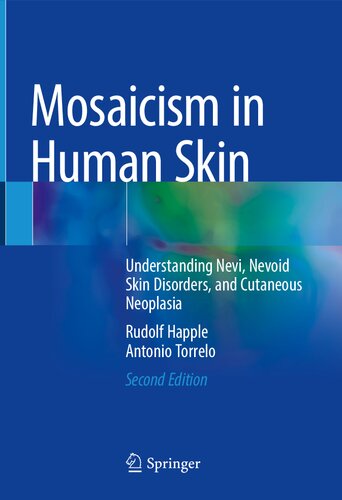موزائیسم در پوست انسان: درک خال ها، اختلالات پوستی ناویوئید و تومورهای پوستی ۲۰۲۲
Mosaicism in Human Skin: Understanding Nevi, Nevoid Skin Disorders, and Cutaneous Neoplasia 2022
دانلود کتاب موزائیسم در پوست انسان: درک خال ها، اختلالات پوستی ناویوئید و تومورهای پوستی ۲۰۲۲ (Mosaicism in Human Skin: Understanding Nevi, Nevoid Skin Disorders, and Cutaneous Neoplasia 2022) با لینک مستقیم و فرمت pdf (پی دی اف)
| نویسنده |
Antonio Torrelo, Rudolf Happle |
|---|
| تعداد صفحهها |
243 |
|---|---|
| نوع فایل |
|
| حجم |
27 Mb |
| سال انتشار |
2022 |
89,000 تومان
معرفی کتاب موزائیسم در پوست انسان: درک خال ها، اختلالات پوستی ناویوئید و تومورهای پوستی ۲۰۲۲
این ویرایش دوم کار کاملاً اصلاح شده و به روزرسانی شده ای را در زمینه ای از دانش که به سرعت در حال رشد است، ارائه می کند که توسط دو متخصص تهیه شده است که هدفشان توضیح پایه های مولکولی اختلالات پوستی موزاییکی به زبانی است که برای پزشکان و پزشکان شاغل در دسترس است. دانش آموزان به طور یکسان یک مرور کلی به موقع و جامع از الگوهای متنوع و علائم اختلالات پوستی موزاییکی را به روشی ساده و خوانا ارائه می دهد که به پزشکان کمک می کند تا مشاوره ژنتیک و نتایج درمان را بهبود بخشند.
دو بخش اول کتاب به مکانیسم ها و الگوهای موزائیسم پوستی اختصاص دارد و شامل توضیحی از موزاییکیسم ژنومی و اپی ژنتیکی و توصیفی از الگوهای قطعه ای معمولی از جمله خطوط بلاشکو و فلوید مانند پرچم است. الگوی جانبی و غیرقطعی خال های ملانوسیتی مادرزادی آرایش بزرگ و روسری مانند نیز در نوع خاصی از سه رنگ دیده می شود. مفهوم جهش یافته های کشنده زنده موزائیک اکنون با تجزیه و تحلیل مولکولی در چندین فنوتیپ پراکنده تأیید شده است. تفاوت بین صفات تک والدینی و دیپلوئیدی درک ما را از موزائیسم ژنتیکی، به ویژه تومورهای خوش خیم پوستی متعدد، عمیق تر کرده است. علاوه بر این، تشخیص تفاوت اساسی بین نوع سگمنتال ساده و انواع موزاییکی همپوشانی برای هدف مشاوره ژنتیک مهم است. در بخش سوم، اختلالات پوستی موزائیک متنوعی به طور عمیق مورد بررسی قرار گرفته است، از جمله خال ها، سایر اختلالات پوستی، تظاهرات موزاییکی اختلالات پوستی بدنی، و اختلالات پوستی شریانی مانند فنوتیپ هایی که منعکس کننده موزائیکیسم کروموزوم X عملکردی یا تظاهرات موزاییکی همپوشانی بیماری های پوستی رایج با زمینه های متعدد هستند. ژن ها این برنامه کاربردی Mozaics in Human Skin خواننده پسند و با ساختار واضح برای متخصصین پوست و دستیاران با تجربه و همچنین متخصصان ژنتیک پزشکی و متخصصان اطفال قابل دسترسی است.
This second edition offers a fully revised and updated work on a rapidly growing field of knowledge, and was prepared by two experts whose goal was to explain the molecular basis of mosaic skin disorders in a language that is accessible for practicing physicians and medical students alike. It presents a timely and comprehensive overview of the strikingly manifold patterns and peculiarities of mosaic skin disorders in a straightforward, reader-friendly way that will help physicians to further improve genetic counseling and treatment outcomes.
The first two parts of the book are devoted to the mechanisms and patterns of cutaneous mosaicism, and include an explanation of genomic and epigenetic mosaicism and a description of the archetypical segmental patterns including the lines of Blaschko and the flag-like, phylloid and lateralization pattern, the non-segmental pattern of large congenital melanocytic nevi, and the sash-like arrangement as noted in a particular type of cutis tricolor. The concept of lethal mutations surviving as mosaics has now been confirmed by molecular analysis in many sporadically occurring phenotypes. The difference between monoallelic and biallelic traits has deepened our understanding of hereditary mosaics, especially of multiple benign skin tumors. Moreover, recognition of the fundamental difference between the simple segmental and the superimposed types of mosaicism is important for the purpose of genetic counseling. In the third part, the various mosaic skin disorders are examined in depth, including nevi, didymotic disorders, other binary genodermatoses, mosaic manifestations of autosomal skin disorders, and nevoid skin disorders such as phenotypes reflecting functional X-chromosome mosaicism or a superimposed mosaic manifestation of common skin diseases with a polygenic background. Reader-friendly and clearly structured, Mosaicism in Human Skin will appeal to both experienced dermatologists and residents in training, as well as to medical geneticists and pediatricians.



